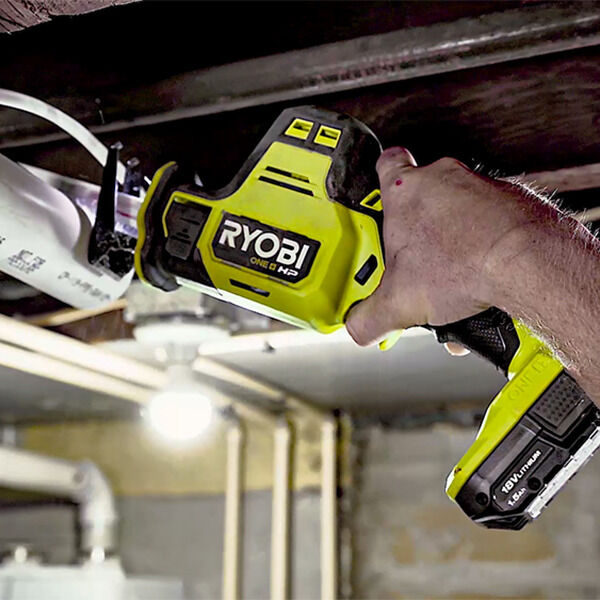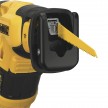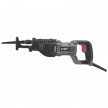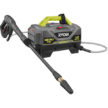RYOBI cordless compact one handed reciprocating saw
RYOBI cordless compact one handed reciprocating saw
The ryobi cordless compact one handed reciprocating saw is a good example of the constant innovation in the tool industry. New tools are introduced every year, and sometimes new kinds of tools are introduced. A new kind of tool that’s proven extremely useful and welcome these last couple of years is the cordless compact one-handed reciprocating saw. Model PSBRS01 is RYOBI’s competitor in this space, and it will find a ready market in both DIY and pro applications.
- Compact size at 13” and light weight
- Brushless motor provides variable 0-3,000 SPM
- 5/8″ stroke length
- LED work light
- Pivoting, but not extensible, shoe
- Keyless blade changes
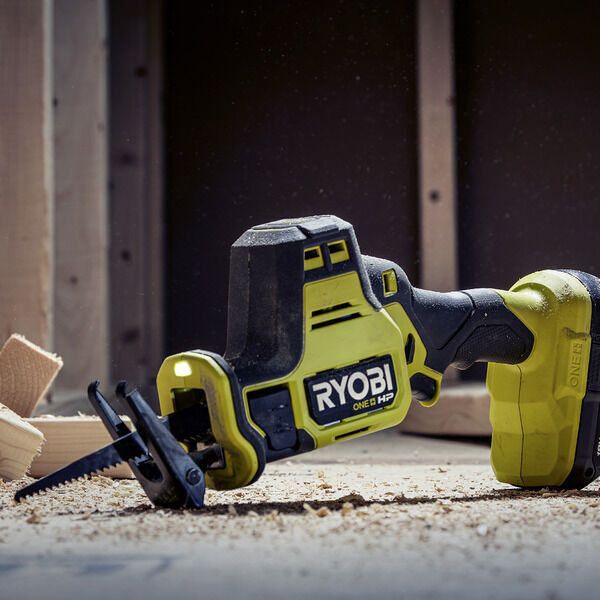
The 13” length is ideal for tight spaces and overhead applications. While the 5/8” stroke length is on the lowish side for this class of tool, the 0-3000 SPM speed is common. The keyless blade change is a great feature, as anyone who’s ever lost a key will attest.
Task dictates function
Before we talk about a tool’s performance, we first have to be realistic in how we evaluate it, which means being realistic about what this kind of tool is intended for. A one-hand recip saw isn’t a production tool; if you have lots of 2X stock to cut, then a circular saw or miter saw is usually the right tool. If you have a rack of steel pipe to cut, then a cut-off saw or a two-handed recip saw is probably the right tool. A one-hand recip saw by contrast is often meant for convenience—such as when you don’t want to set up a miter saw, or for very tight quarters. Both situations are only occasional and neither is a high duty cycle, let alone a production, situation. Blazing speed isn’t important here. Of course, there are possible production applications for a saw that like this that can be hung from a belt — replacement window installers come to mind, and their requirements will of course be more stringent. But for most people this is a small tool for the odd circumstance, but one that is a real life-saver at those times.
We should also note that a recip saw of any kind isn’t a precision instrument. Mostly you’re trying to rip something apart…and sometimes outright destroy it. I’ve yet to see a finish carpenter use one for any purpose other than rough-in work or demo.

Use a tool as intended
Now I’m not a big oaf — I’m more of a medium-size oaf — but I can probably break any tool if you let me at it for a while. Have, in fact. And knowing that, when I was a wee lad my dad taught me two things that I assume every trade person’s mentor taught them at some point. 1) Don’t force things; if you have to force something, then something’s not right. 2) Let the tool do the work (which usually means keeping it sharp). Since this kind of saw isn’t generally meant as a production tool, there’s no need to lean into it with your body weight to hurry it along. Let the saw do the work, and don’t force things — that’s the way it’s meant to be used.
RYOBI is of course The Home Depot’s entry-level power tool brand, and it’s entry-level because of its attractive pricing. But the price of the tool has nothing to do with its quality in the context of the job it’s intended for. People often make the mistake of labeling tool brands as “cheap” vs “quality”, or “DIY-grade” vs “pro-grade”. The better way to look at it, in my opinion, is “designed for low duty cycle use” vs “designed for high duty cycle use”. Certainly lower-priced tools can’t be designed to withstand the constant day-in/day-out use and abuse that more expensive materials and manufacturing methods can provide, but they’re perfectly designed to provide excellent service for less than all-out duty cycles. That’s true for anything, whether we’re talking about automobiles, pencils, can openers…or power tools.
As I mentioned in another review, I’ve lost track of the number of professional tradies —carpenters, plumbers, electricians, tile setters, oil burner techs, and more —who’ve told me that they’ve gotten excellent service from their RYOBI tools. They use their RYOBI tools for those tasks that they do occasionally or at a low duty cycle, even if every day. RYOBI is made for The Home Depot by TTI, and for those tasks that require high duty cycle tool use, TTI makes, and The Home Depot sells, another line of (naturally more expensive) tools: Milwaukee.
HP tools and batteries
This compact recip saw is part of the new HP (high performance) line of RYOBI tools. These HP tools feature brushless motors and a compact design. The two are not completely unrelated. We all know by now that brushless motors provide more power and longer life than their brushed equivalents, and the greater power density of these motors makes more compact tool possible.
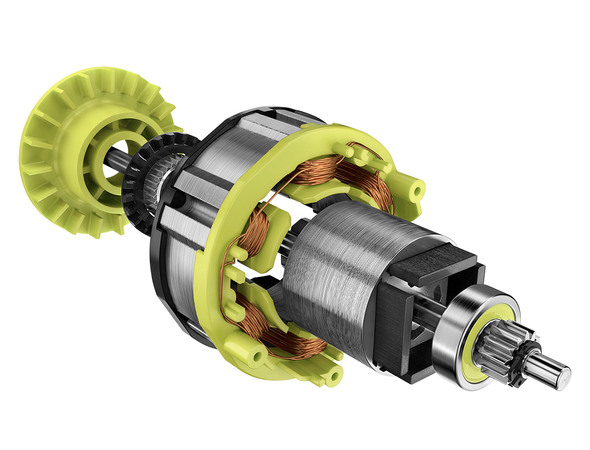
RYOBI makes four kinds of 18-volt batteries, all of which will work in any 18-volt ONE+ tool. The NiCad versions were the first generation, and you hardly see them anymore. The first generation Lithium batteries are still in wide circulation, and the follow-on Lithium+ batteries, with additional run-time and power, have until recently been the flagship of the 18-volt line. RYOBI’s new HP tools are designed to work optimally with their new Lithium+HP batteries, which are “intelligent”. Not Stephan Hawking intelligent, but more like they have control circuitry that allows for communication with the HP brushless tools via two extra electrodes. Basically the tool can call for additional power when needed (Scotty, I need more power!). But, in an interesting twist, although this one-hand recip saw is an HP tool, it doesn’t have the extra contact points to communicate with Lithium+HP batteries. Nonetheless, you’ll still see some difference in performance based on the size (Ah) of battery you use with this tool (more Ah=better performance) because larger batteries have more cells over which to distribute the called-for load.
Ergonomics
First, in the hand, this saw is well balanced, especially with the smaller batteries. This is important because the saw is intended to be used in odd and tight spaces. You don’t want to be stretched out, possibly a little off balance, trying to reach into a tight space and applying pressure against the blade AND have to fight the saw’s tendency to roll out of position.
The grip is comfortable, with the overmolded bits all in the right places. The trigger and lockout are easy to reach and operate. Blade changes are a breeze: just lift up the lever and go to it —no more fiddling (and losing) hex keys. And vibration was not at all bad —that’s not faint praise. Recip saws, by their nature, often feel like mini jack hammers, and vibration is just part of using the tool. This RYOBI saw, though, did not provide an uncomfortable amount.

The only thing I’d like to see improved is a brighter LED work light. It’s bright by the standard of many cordless tools, but more lumens are always welcome, especially since this tool is designed for tight, overhead, usually dimly lit and just generally funky spaces.
Test cutting
I envision using this saw for two primary purposes: as something easy to grab to make a cut or two in wood, and as something compact to get into tight spaces — most likely to cut wood, PVC or copper.
The RYOBI cordless compact one handed reciprocating saw is like any other saw in that cutting performance is as much — actually more — dependent on the blade as on the saw itself. Nowadays there are countless saw blades available for every conceivable task and material, and they also vary by the material they’re made from, tooth count, tooth geometry…the list goes on. So trying to give an extensive technical description of this saw’s performance with various blades in various materials is beyond me. And I don’t really care. I just want it to do the jobs I have it for acceptably well. To that end I’ve done what most people do: stocked up on the most common blades that I might need, and I pick the likely best of the lot for the job at hand.
I first used this saw to break up a wind-downed lilac tree, as you can see in the picture below. I was using a Diablo pruning blade and it took me about a minute to cut through the branch, which kinda surprised me until I remembered just how hard lilac is (all my lilac trimming and cutting recently has been with a small chain saw). Note that I was using the small 2Ah battery.

I changed to a Diablo 14 TPI Steel Demon blade to cut some thick-walled half-inch steel pipe of unknown composition or purpose. 20 seconds max with the small 2Ah battery, and noticeably quicker with the 6Ah battery.
Changing blades again to a Diablo 6/12 TPI Demo Demon blade, I cut halfway through a 2×6 KD with the 2Ah battery before swapping to the 6Ah battery to finish the cut. Maybe 10 seconds total cut time.
One of the attractive reasons to own a one-hand recip saw in my opinion is to reach between studs and joists in case you have to make a cut in one of them. I slapped together a couple 2x6s and some OSB to make the mock-up you see below. Note that the RYOBI cordless compact one handed reciprocating saw fit between the 16-on-center members with room to spare (with the 2Ah battery). Once there I was easily able to cut a notch in one of the 2x6s. Sure beats trying to wrestle a larger recip saw into a good cutting position, or using a hand saw and busting up your knuckles.
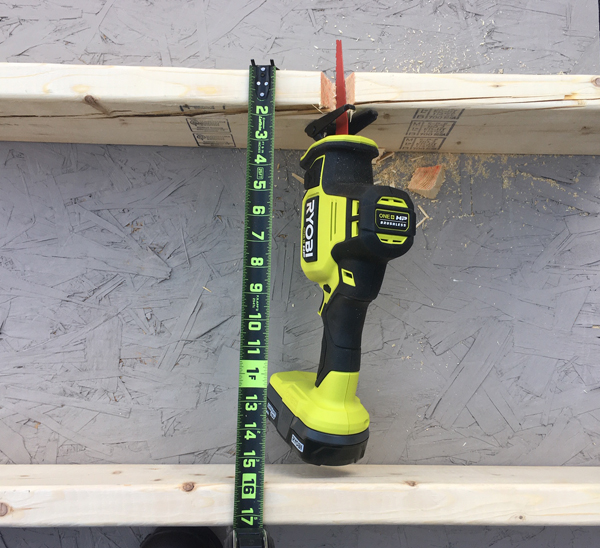
Bottom line
For its intended application as an occasional-use tool, mostly for tight spaces, the RYOBI ONE+ HP 18V Brushless Cordless Compact One-Handed Reciprocating Saw fits the bill well. While there may be some production applications for this class of tool, for most tradies this will one of those “thank heaven I’ve got it” tools that you grab now and then. $99 at The Home Depot.



